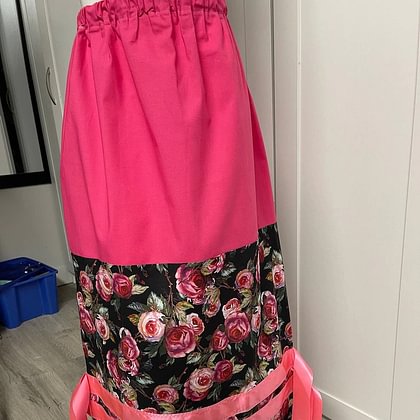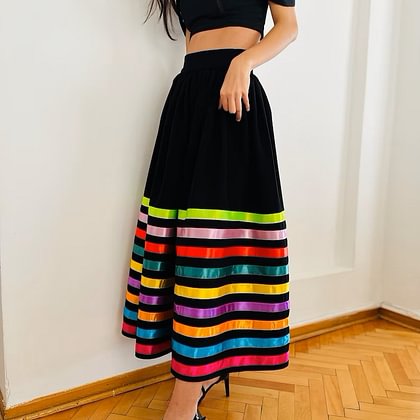In the dynamic world of First Nations attire, ribbon skirts hold a unique place, embodying both cultural value and aesthetic beauty. These garments, historically worn by First Nations women, are not just apparel; they are a delicately crafted tapestry of narrative, cultural identity, and tradition. With their bright colors and intricate designs, these skirts showcase the unique heritage of different tribes, each with their own styles and techniques that reflect their cultural narratives.
As an emblem of strength and pride, these skirts have gained increased popularity, serving as a platform for women to commemorate their lineage while adopting current fashion. Every skirt tells a tale through its colors and patterns, often incorporating iconography that connect the wearer to their roots. Exploring the patterns of these skirts reveals a deep cultural artistry that continues to ennoble and uplift, making them a significant symbol of Native identity in the contemporary world. spintax ### History of Ribbon Skirts
These skirts have significant roots in the culture of Indigenous Peoples, particularly among Plains Nations. Traditionally, https://www.ribbonskirts.com/collections/ribbon-skirt were made from traded textiles and decorated with colorful ribbons, which symbolize identity and cultural heritage. As trade expanded in the 19th century, the access to diverse materials enabled varied designs and styles. https://www.ribbonskirts.com/collections/native-american-ribbon-skirts became a canvas for artistic expression, allowing women to showcase their creativity while respecting their heritage.
In numerous Indigenous communities, ribbon skirts are worn during significant events such as ceremonies , gathering ceremonies, and other cultural gatherings. Each design often tells a story , reflecting the wearer's personal journey, family history, or tribal affiliation. The use of bright colors and intricate patterns signifies the rich traditions and the importance of storytelling within Native American cultures. Over time, these garments have also been embraced as symbols of resilience and empowerment.
Today , ribbon skirts continue to evolve while maintaining their cultural significance. Modern artisans often mix traditional techniques with contemporary designs, ensuring that the legacy of these skirts lives on. By wearing ribbon skirts, Indigenous women celebrate their heritage, connect with their ancestors, and inform the wider community about their culture's beauty and meaning. This ongoing journey of creation and adaptation showcases the lasting impact of ribbon skirts within the Native American community.
Cultural Significance
First Nations ribbon skirts carry significant cultural meaning and are often viewed as emblems of identity and tradition. The use of bright ribbons in these skirts symbolizes the connection to cultural roots and the stories of the ancestors. Each hue and style can represent different aspects of life, resilience, and the spirit of the community. Wearing these skirts during ceremonies reinforces cultural pride and serves as a reminder of the vast histories that are woven into each design.
The craftsmanship involved in designing ribbon skirts is not only an art form but also a way to pass down knowledge from one generation to another. Elders teach younger generations the methods and the significance behind each element included into the skirts. This sharing of skills fosters a sense of unity and connection within communities, as each skirt becomes a collective representation of traditional legacy.
Furthermore, ribbon skirts are often worn during important cultural gatherings and ceremonies, such as festivals and tribal celebrations. Their colorful designs not only add beauty to these gatherings but also assert the presence and role of Native women in these contexts. By wearing ribbon skirts, individuals assert their identity and proudly showcase their cultural heritage, contributing to the enduring visibility of Indigenous traditions in contemporary society.

Modern Interpretations
Recently, Native American ribbon skirts have witnessed a resurgence in popularity, both serving a fashion icon and a symbol of heritage pride. Contemporary designers are adopting the classic elements of ribbon skirts and blending them with contemporary aesthetics, creating unique pieces that appeal with younger generations. This blend of styles enables self-expression while honoring the history and significance of the craft.

Social media has played a vital role in the revival of ribbon skirts, with countless creators showcasing their designs online. Many artisans are embracing vibrant colors and innovative patterns while maintaining the traditional construction methods. These platforms have fostered a sense of community among wearers and makers, enabling the sharing of ideas, techniques, and experiences connected to these garments.
Additionally, ribbon skirts are being adopted in various settings, from powwows to fashion shows, highlighting their versatility. Designers are now producing skirts that not only function as traditional attire but also blend perfectly into everyday wear. This evolution demonstrates the evolution of native american ribbon skirts, making them significant and appreciated in contemporary culture, while continuing to inform others about their vibrant heritage.
